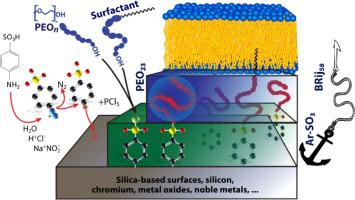Colloids and Surfaces B: Biointerfaces ( IF 5.4 ) Pub Date : 2020-10-20 , DOI: 10.1016/j.colsurfb.2020.111427 Ophélie Squillace 1 , Thomas Perrault 1 , Magdalena Gorczynska 2 , Andrew Caruana 3 , Anna Bajorek 4 , Guillaume Brotons 1

|
We describe a bottom-up surface functionalization to design hybrid molecular coatings that tether biomembranes using wet chemistry. First, a monolayer was formed by immersion in a NH2-Ar-SO3H solution, allowing aryldiazonium salt radicals to spontaneously bind to it via strong C bonding. After formation of the air-stable and dense molecular monolayer (–Ar-SO3H), a subsequent activation was used to form highly reactive –Ar-SO2Cl groups nearly perpendicular to the monolayer. These can bind commercial surfactants, PEGylated oligomers and other inexpensive molecules via their -OH, -COOH, or -NH2 chain end-moieties, to build hybrid coatings. Metal and oxidized chromium, semi-conductor n-doped silicon (111), are the substrates tested for this protocol and the aromatic organic monolayers formed at their surface are characterized by X-ray photoelectron spectroscopy (XPS). XPS reveals unambiguously the presence of C–Cr and C–Si bonds, ensuring robustness of the coatings. Functional sulfur groups (–SO3H) cover up to 6.5×10−10 mol cm−2 of the silicon interface and 4.7×10−10 mol cm−2 of the oxidized chromium interface. These surface concentrations are comparable to the classic values obtained when the prefunctionalisation is driven by electrochemistry on conductors. Tethered lipid membranes formed on these coatings were analyzed by neutron reflectivity at the interface of functionalized n-doped silicon substrates after immersion in a solution of lipid vesicles and subsequent fusion. Results indicate a rather compact hybrid coating of Brij anchor-harpoon molecules that maintain a single lipid bilayer above the substrate, on top of a hydrated PEO cushion.
中文翻译:

通过湿化学通过芳基重氮磺酸自发接枝到硅和铬上来设计拴系双层脂质膜
我们描述了一种自下而上的表面功能化技术,以设计使用湿化学方法束缚生物膜的混合分子涂层。首先,通过浸入NH 2 -Ar-SO 3 H溶液中形成单分子层,使芳基重氮盐自由基通过强C键自发结合。形成空气稳定且致密的分子单分子层(–Ar-SO 3 H)后,随后的活化作用用于形成几乎垂直于单分子层的高反应性–Ar-SO 2 Cl基团。这些可以通过它们的-OH,-COOH或-NH 2结合市售表面活性剂,聚乙二醇化低聚物和其他廉价分子链端部分,以建立混合涂料。金属和氧化铬,半导体n掺杂硅(111)是为此协议测试的衬底,并且通过X射线光电子能谱(XPS)对在其表面形成的芳族有机单层进行了表征。XPS明确显示出C-Cr和C-Si键的存在,从而确保了涂层的坚固性。功能性硫基团(–SO 3 H)覆盖硅界面的最大6.5×10 -10 mol cm -2和4.7×10 -10 mol cm -2的氧化铬界面。这些表面浓度可与通过导体上的电化学作用进行预官能化获得的经典值相比。浸入脂质囊泡溶液中并随后融合后,通过在功能化的n掺杂硅衬底界面处的中子反射率分析在这些涂层上形成的拴系脂质膜。结果表明Brij锚-鱼叉分子的相当紧凑的杂化涂层,在水合PEO垫层的顶部,在基质上方保持单个脂质双层。











































 京公网安备 11010802027423号
京公网安备 11010802027423号